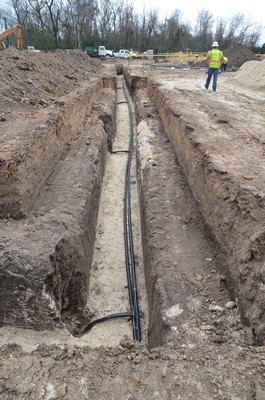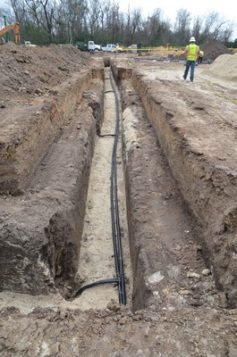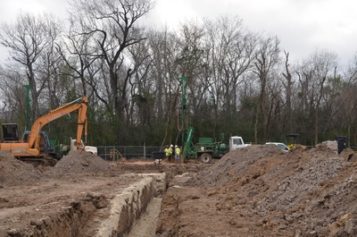
HOUSTON, Texas — City employees and construction professionals recently gathered at a Greenspoint area construction site to gain an understanding of the GeoExchange HVAC plan being installed in the City’s new Fire Station #84.
Since the city council adopted the Green Building Resolution in 2004, all new construction with more than 10,000 square feet of occupied space must be LEED certified. As part of this initiative to build more efficient, sustainable buildings, this is the first system of its kind on a project funded by the city of Houston, Texas.
Laif Nilson, senior project engineer, with the selected contracting firm, JE Dunn Construction, says, “I have worked with the city on a few other projects. I am glad to see them embracing this energy-saving technology and am excited to be a part of this significant effort.”
GeoExchange technology uses a series of sealed piping loops buried in the ground to tap the renewable energy of the earth. In the winter, heat that accumulates in the soil is absorbed by a system of pipes buried within the earth and then used to provide heating to a building. In the summer, the process is reversed – excess heat from the building is collected and transferred to the earth.
These buried loops transfer energy by means of circulating water and create a better heat transfer medium than traditional air source systems. They are on average 48 percent more efficient than gas furnaces on a source fuel basis, and over 75 percent more efficient than oil furnaces. In fact, GeoExchange systems can outperform the best gas technology, gas heat pumps, by an average of 36 percent in heating mode and 43 percent in cooling mode.
The U.S. Environmental Protection Agency identified GeoExchange systems as the most energy-efficient, environmentally clean and cost-effective space conditioning system available today.1
Russell Buras of LoopTech, who is installing the system at Station 84, points out that, “Although it typically costs more to install a GeoExchange system, the operational savings are around 30 percent in cooling mode and 70 percent in heat mode. Sometimes the payback period is less than 5 years.”
Buras also outlines some other advantages over standard HVAC systems:
- Minimal maintenance: 50+ year lifecycle on loop field
- Dependable service
- Enhanced aesthetic: no outside exposed equipment
- Less noise pollution
- Free hot water
- Minimal liability: 5-10 year warranty
- Green friendly
- Vandal/hurricane proof
Fire Station 84 will be approximately 14,000 square feet with five drive-thru bays, maintenance and EMT areas, fueling island, living quarters, kitchen, lounge, exercise area, locker rooms and bathrooms. LEED Silver certification with the USGBC will be pursued.
The new fire station, located in the 300 block of Gears Road, near Ella Boulevard and Beltway 8, will relieve over-extended resources within the city. Currently, the nearest fire station is over 4.5 miles away.
1Environmental Protection Agency, Space Conditioning: The Next Frontier, 430-R-93-004.




 Join our thriving community of 70,000+ superintendents and trade professionals on LinkedIn!
Join our thriving community of 70,000+ superintendents and trade professionals on LinkedIn! Search our job board for your next opportunity, or post an opening within your company.
Search our job board for your next opportunity, or post an opening within your company. Subscribe to our monthly
Construction Superintendent eNewsletter and stay current.
Subscribe to our monthly
Construction Superintendent eNewsletter and stay current.